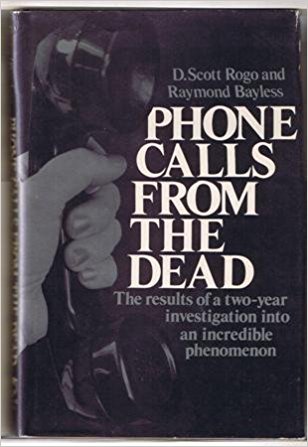So it’s not secret by now that I find subjects like this very interesting, apart from EVP’s and videos of bizarre interferences I find any electronic signals to be interesting, such as numbers stations for example. I realise that one of the ones I had not raised here was the concept of being called beyond the grave.
Is the telephone a way to make a last goodbye? To give a deceased person a change to make one last communication before moving on? Quite extensive research has been made, Phone Calls From the Dead (1979) by D Scott Rogo and Raymond Bayless, was the result of their two year research into the matter. In 2012 another book by Callum E Cooper also picked up the subject.
The types of calls appear to fall into three main categories and one is where the witness receives a call from someone who died, sometimes not that recently but either way for the most part the witness knows that the caller is dead and it is rare that they are not aware of it when the call comes in.
Another variation is that the witness gets a call from the deceased but discover their death afterwards. Often it seems to come from the phone of a relative or friend and they did not call, but for an unknown reason had thought about calling them, the voice is unusually strong compared to the faded static type. Some witnesses said it was odd because that person sounded quite mechanical or possibly even drunk.
A rarer but report case is also noted of people calling to the deceased, not intentionally, to find that the conversation they’d had should not have been possible. The person that answered was dead or perhaps the person they should have been talking too was not even in that place at the time.
One of the most famous incidents of this type is by Charles E Peck’s calls on 12th September 2008. At 4:22pm a commuter train with 225 people on board collided with a freight train in San Fernando’s Valley, California, and the 49 year old Charles Peck was on board. 25 people died, 135 were injured and of the injured they sent 87 to hospital, 46 were in a critical condition.
Peck had been travelling for a job in another area, he could then plan his wedding to his second wife once they were closer together, Andrea Kalz was his fiancée and from his prior marriage he had three fully grown children. Andrea heard about the crash on the radio whilst heading to the station to collect him. Peck;s parents and siblings already lived in the area and they came to join her whilst they waited for news.
In the first eleven hours of the wait there were calls from his cellphone suggesting that he was alive. Calls were made to his son, brother, stepmother, sister and fiancée. In all there were 35 calls and they would answer to hear static, understandably they would call back but the call then went to voicemail. The calls meant that the crews were prompted to use his signal to aid in the search, they looked again into the location and at 12 hours after the crash they found him.
Peck was deceased, declared dead on the scene and the resulting investigations showed he had died on impact. Long past his death his cell phone had carried on reaching out to loved ones. Unfortunately they were unable to retrieve the phone or there is no evidence that it was found.
Interestingly enough in regards to the Peck case, it seems that Snopes have decided that there was enough evidence to class this as true.



